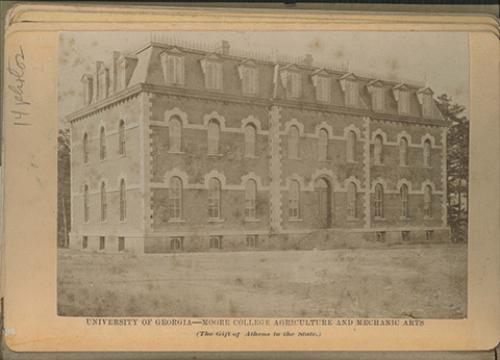Moore College – UGA 25 (1874–1876, 2001; Category 2). Constructed between 1874 and 1876, Moore College is the only building on campus that dates to the late nineteenth century. Faced with a lack of state legislature funding, and a growing student body, the University was challenged to grow in the post-Reconstruction period. With the state legislature’s acceptance of the federal Land Grant College program support for establishment of an agricultural and mechanical college in Georgia in 1872, Athens was selected by the governor as the location for the new state college. Richard Moore, an Athens physician and member of the University’s board of trustees, was influential in persuading the city of Athens to contribute funds for a building to house the State College of Agricultural and Mechanical Arts.
Named Moore College and sited west of the existing Franklin College, the new building was considered an independent institution and was designed to face Broad Street rather than the quadrangle.
Designed by Professor Leon Henri Charbonnier, a graduate of the French military school at St. Cyr and professor of mathematics and engineering at the University, Moore College was completed in 1876 in the Second Empire style. The building served the needs of technical and scientific classes related to land grant programs. Physics remained housed in the building until the Science Center was completed in the 1950s. The Department of Romance Languages later used the building.
Moore College was renovated in the late 1930s using Public Works Administration funding. Its exterior stucco is believed to have been installed at that time. Moore College was again renovated in 2001 to accommodate current use by the University’s Honors Program. It is listed as a contributing building in the Old North Campus Historic District.
Moore College has a painted stucco exterior that is scored to resemble stone. The building retains its original wood double-hung windows and has no screen or storm windows. Synthetic slate has been installed on the building’s Mansard roof. The interior has been substantially rehabilitated. Moore College retains a high degree of integrity on the exterior and appears to contribute to a National Register-eligible historic district. It is assessed as a Category 2 resource.

